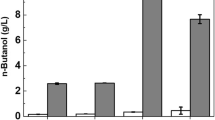Abstract
Optimum values of temperature, pH, and starting substrate concentration are experimentally determined for 2,3-butanediol production by Enterobacter aerogenes through three set of batch fermentations of synthetic glucose solutions. The results of tests carried out at variable temperature show an optimum of 39 °C and are used to estimate, for both fermentation and thermal inactivation, the activation enthalpies (7.19 and 23.6 kJ mol−1) and the related entropies (−0.32 and −0.27 kJ mol−1 K−1). An optimum pH value of 6.0 is evidenced from batch runs at variable pH, whose results are also used to make reasonable hypotheses on the reaction controlling the metabolic pathway which leads to butanediol. The fermentability of different food industry wastes, namely starch hydrolysate, both raw and decoloured molasses, and whey, is finally checked.
Similar content being viewed by others
Author information
Authors and Affiliations
Additional information
Received: 5 December 1999
Rights and permissions
About this article
Cite this article
Perego, P., Converti, A., Del Borghi, A. et al. 2,3-Butanediol production by Enterobacter aerogenes: selection of the optimal conditions and application to food industry residues. Bioprocess Engineering 23, 613–620 (2000). https://doi.org/10.1007/s004490000210
Issue Date:
DOI: https://doi.org/10.1007/s004490000210




